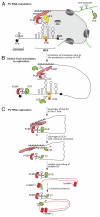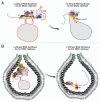Diverse roles of host RNA binding proteins in RNA virus replication
- PMID: 21505273
- PMCID: PMC3230553
- DOI: 10.4161/rna.8.2.15391
Diverse roles of host RNA binding proteins in RNA virus replication
Abstract
Plus-strand +RNA viruses co-opt host RNA-binding proteins (RBPs) to perform many functions during viral replication. A few host RBPs have been identified that affect the recruitment of viral +RNAs for replication. Other subverted host RBPs help the assembly of the membrane-bound replicase complexes, regulate the activity of the replicase and control minus- or plus-strand RNA synthesis. The host RBPs also affect the stability of viral RNAs, which have to escape cellular RNA degradation pathways. While many host RBPs seem to have specialized functions, others participate in multiple events during infection. Several conserved RBPs, such as eEF1A, hnRNP proteins and Lsm 1-7 complex, are co-opted by evolutionarily diverse +RNA viruses, underscoring some common themes in virus-host interactions. On the other hand, viruses also hijack unique RBPs, suggesting that +RNA viruses could utilize different RBPs to perform similar functions. Moreover, different +RNA viruses have adapted unique strategies for co-opting unique RBPs. Altogether, a deeper understanding of the functions of the host RBPs subverted for viral replication will help development of novel antiviral strategies and give new insights into host RNA biology.
Figures


Similar articles
-
Host RNA-binding proteins and specialized viral RNA translation mechanisms: Potential antiviral targets.Antiviral Res. 2025 May;237:106142. doi: 10.1016/j.antiviral.2025.106142. Epub 2025 Mar 13. Antiviral Res. 2025. PMID: 40089163 Review.
-
The potential of RNA-binding proteins as host-targeting antivirals against RNA viruses.Int J Antimicrob Agents. 2025 Aug;66(2):107522. doi: 10.1016/j.ijantimicag.2025.107522. Epub 2025 Apr 20. Int J Antimicrob Agents. 2025. PMID: 40258479 Review.
-
A Balancing Act: The Viral-Host Battle over RNA Binding Proteins.Viruses. 2024 Mar 20;16(3):474. doi: 10.3390/v16030474. Viruses. 2024. PMID: 38543839 Free PMC article. Review.
-
Reconstitution of an RNA Virus Replicase in Artificial Giant Unilamellar Vesicles Supports Full Replication and Provides Protection for the Double-Stranded RNA Replication Intermediate.J Virol. 2020 Aug 31;94(18):e00267-20. doi: 10.1128/JVI.00267-20. Print 2020 Aug 31. J Virol. 2020. PMID: 32641477 Free PMC article.
-
Plus-strand RNA viruses hijack Musashi homolog 1 to shield viral RNA from cytoplasmic ribonuclease degradation.J Virol. 2025 Mar 18;99(3):e0002325. doi: 10.1128/jvi.00023-25. Epub 2025 Feb 12. J Virol. 2025. PMID: 39936918 Free PMC article.
Cited by
-
Cooperativity in RNA-protein interactions: global analysis of RNA binding specificity.Cell Rep. 2012 May 31;1(5):570-81. doi: 10.1016/j.celrep.2012.04.003. Cell Rep. 2012. PMID: 22708079 Free PMC article.
-
Nucleotide triphosphatase and RNA chaperone activities of murine norovirus NS3.J Gen Virol. 2018 Nov;99(11):1482-1493. doi: 10.1099/jgv.0.001151. Epub 2018 Sep 28. J Gen Virol. 2018. PMID: 30265237 Free PMC article.
-
The multifarious roles of heterogeneous ribonucleoprotein A1 in viral infections.Rev Med Virol. 2020 Mar;30(2):e2097. doi: 10.1002/rmv.2097. Epub 2020 Jan 27. Rev Med Virol. 2020. PMID: 31989716 Free PMC article. Review.
-
Neurodevelopmental protein Musashi-1 interacts with the Zika genome and promotes viral replication.Science. 2017 Jul 7;357(6346):83-88. doi: 10.1126/science.aam9243. Epub 2017 Jun 1. Science. 2017. PMID: 28572454 Free PMC article.
-
Epigenetic Lens to Visualize the Severe Acute Respiratory Syndrome Coronavirus-2 (SARS-CoV-2) Infection in COVID-19 Pandemic.Front Genet. 2021 Mar 22;12:581726. doi: 10.3389/fgene.2021.581726. eCollection 2021. Front Genet. 2021. PMID: 33828579 Free PMC article. Review.
References
-
- Kolakofsky D, Weissmann C. Q[beta] replicase as repressor of Q[beta] RNA-directed protein synthesis. Biochimica et Biophysica Acta (BBA) - Nucleic Acids and Protein Synthesis. 1971;246:596–599. - PubMed
-
- Dreher TW. Functions of the 3′-untranslated regions of positive strand RNA viral genomes. Annu Rev Phytopathol. 1999;37:151–174. - PubMed
Publication types
MeSH terms
Substances
LinkOut - more resources
Full Text Sources
Miscellaneous
